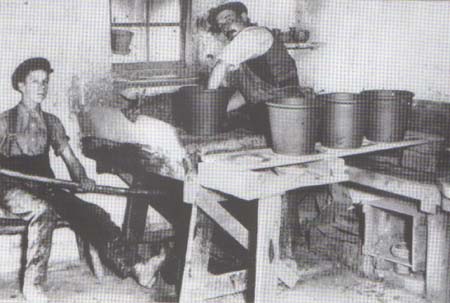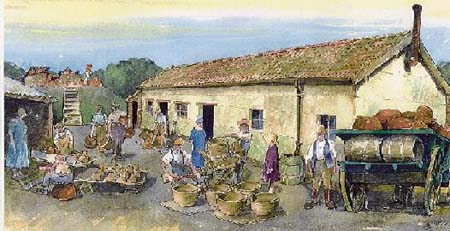 Two people were
needed to throw a pot, one threw the pot while the other man
manipulated the wheel to the speed required by the
potter. The complete harmony of both was essential and
after experience, this was obtained without a word being
spoken. The picture shows Mr. Herbert
Bailey (known as Bert) finishing a pot with Mr. Harold
Churchill operating the hand-driven wheel.
Two people were
needed to throw a pot, one threw the pot while the other man
manipulated the wheel to the speed required by the
potter. The complete harmony of both was essential and
after experience, this was obtained without a word being
spoken. The picture shows Mr. Herbert
Bailey (known as Bert) finishing a pot with Mr. Harold
Churchill operating the hand-driven wheel.
There were two wheels which at one time were worked
all day long, ten men being employed. The older
and larger wheel was mechanically very simple. An assistant
sat at one side holding the long, rough pole which was
connected to a crankshaft, directly attached, to the wheel
head. By pushing the pole backwards and forwards
the wheel was turned.
The second wheel was smaller and an assistant was
required to turn a handle. This was connected to
the cog wheels and chain of an old bicycle set in a heavy
wooden frame.
Both these wheels were used for many years, the
potters preferring them to the electric wheel installed
during the latter years.
When a large 'breadcrock'
had been thrown and cut from the wheel it was lifted by two
men, one on either side of the wheel supporting the sides
with their arms.
The drying was done either outside in the sun in
summer, or on sanded boards inside placed in the rafters or
the workroom. Peat was burned on the workroom floor at
night to aid the drying.
The pots were then raw-glazed, very few being
completely glazed. Most were glazed only inside;
jugs were partly glazed outside. In earlier years salt glaze
was used but during latter years powdered galena was sent
from
Liverpool
. The galena was mixed with water and applied with a large
brush. This was allowed to dry completely before
firing, which operation took place only every four to six
weeks, depending on weather conditions, the kiln being in
the open.
The circular kiln was built in a large earth mound
and the kiln chamber resembled a well made of
bricks. The firing chamber was under the well
and had one fire mouth. The floor of the well was perforated
to allow the flames through to the pots.
The kiln was stacked from the top, the operator
climbing down a ladder inside and receiving the pots from
another operator outside. As the pots were usually glazed
only on the inside, smaller ones could be stacked upside
down inside larger ones. Thus little kiln space
was wasted. The pots were stacked on top of one another to
the top of the kiln, which was then covered with sherds.
The fuel used was wood, and firing took up to three
days and nights beginning with a small fire and gradually
building it up to get more heat. During this time the fire
needed constant attention and towards the end of the firing
faggots and gorse were put on to clear the fire and flux the
glaze (flashing). No aids were used to determine
the kiln temperature, this being determined-by the skill and
experience- of the potter. When the. required
temperature was reached certain bricks in the side of the
kiln were watched carefully until they attained a recognised
redness of heat, or until the sherds at the top of the kiln
became coated yellow. One pot was then removed with a piece
of iron with a hook on the. end, for testing.
The kiln was then cooled gradually by blocking up
the entrance to the firing chamber, leaving a very small
hole. When the fire had been let out the kiln was left for
two or three days to cool before it was emptied.
The wood firing brought out the natural red and
green markings. The pots were seldom decorated, although
sometimes a stamp was used, pressed into the pot after
throwing. The stamps were set on a dock wheel mounted on a
handle, which was placed against the pot revolving on the
wheel. The revolving pot turned the clock wheel and the
stamp was repeated round the pot.
The breadcrocks and pitchers were traditionally
Verwood pots. Some other pots made were :- cups,
candle sticks, vases, bird baths, flower pots, money
bottles, ornamental pots, milk jugs, sugar bowls,
casseroles, chamber pots, wash basins and jugs and perfumed
bricks. These bricks were approximately two inches long, one
inch wide and three quarters of an inch deep, and were sent
to a Broadstone perfumery to be perfumed.
Many years ago Verwood potters was exported from
Poole to the continent. In about 1914 twelve of the Verwood
potteries were forced to close partly due to the war and
also to the fact that enamel ware was then on the market at
a reasonable price and was unbreakable.

The remaining pottery is now part of Verwood's
history. It became a tea room and then a hardware store and
has now become the Verwood Heritage Centre.
Apart from treasured pieces of Verwood pottery in the older
folk's homes the last of the pots are now in the Red
House
Museum
at
Christchurch
and at Salisbury
Museum. The electric kiln used in latter
years was sold to the Godshill Pottery and the electric
wheel was collected by two monks for use at the Prinknash
Pottery. One of the original wheels remains and can
still be seen on the premises.
Copyright © P Reeks.